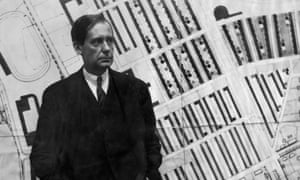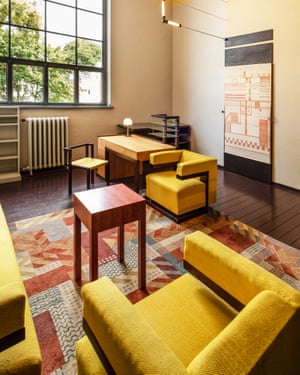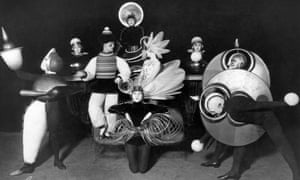Rebel with a cause: how the founder of Bauhaus changed the world
From Richard Rogers to Habitat and Ikea, the influence of the Bauhaus school is everywhere. So why is its charismatic founder, Walter Gropius, still so widely misunderstood?

Arrogant and charmless, obsessed with his own image, even phoney – this is how Walter Gropius, founder of the Bauhaus, the most influential of all art schools, is remembered. He is the rigid disciplinarian, the architect unable to draw. In the five years I’ve spent writing about Gropius’s life, I have often been treated as crazy for taking on such an unsympathetic subject. The architectural historian Joseph Rykwert described Gropius as someone “who seemed to have fewer redeeming features than many of his kind … his pinched humourless egotism was unrelieved by sparkle”. But these received ideas need to be challenged. Why have people got him so wrong?
Why, for instance, has he been regarded as an unromantic figure? In Ken Russell’s 1974 film Mahler he is a dullard. The source of this reputation is found in the self-serving memoir of his first wife, Alma Mahler, And the Bridge Is Love (1959). Here she portrays Gropius as a nonentity in comparison with her other husbands, Gustav Mahler and Franz Werfel, and makes the Bauhaus movement seem like a tedious non-event. Gropius was in fact a charismatic figure, as we can see in records of his later affairs with two particularly interesting women, the artist Lily Hildebrandt and poet Maria Benemann. His love letters are filled with an ardour that will surprise those who imagine that he lacked passion.
Another of the myths I’ve needed to demolish is that Gropius was humourlessly Germanic in his functionalist views. This grim view emanates from Evelyn Waugh’s satiric Professor Otto Friedrich Silenus in Decline and Fall (1928), the architect brought in to design for the fashionable Mrs Beste-Chetwynde “something clean and square”. For many English readers Silenus personified Gropius. This view of Gropius was patently unfair – he was someone who loved the unpredictable: Gropius is never quite what you expect.
He was born in Berlin in 1883. Asked as a small child to name his favourite colour he replied: “Multicoloured is my favourite colour.” He espoused variety, an inclusive view of life’s possibilities, and was someone who made the most of leisure, reading widely. His love of music ranged from Stravinsky to the Beatles. This was a modernist who was deeply appreciative of architectural history; when he lived in London in the 1930s, he was delighted by the beautiful decorum of the city’s 18th‑century terraced housing.
The Bauhaus movement emerged from his traumatic experiences in the first world war, much of it spent fighting on the western front. He later described how “as in a flash of lightning” he realised that “the old stuff was out”. The only possible response was to start again. He used as his model the idealistic concept of the Bauhütte, the medieval stonemasons’ guild, a community of expert artists and craftsmen working together for a common cause. There are traces of William Morris too in his concept of democratic workmanship. The language of Gropius’s original Bauhaus Manifesto and Programme is wonderfully high-flown: “Together let us desire, conceive, and create the new structure of the future, which will one day rise toward heaven from the hands of a million workers like the crystal symbol of a new faith.”
There is a distinctive expressionist fervour in the early work of the Bauhaus school in Weimar. The Sommerfeld House (1920-22), a collaboration between masters and students, with its great prismatic stained glass windows and its jagged style teak carvings, offers a stark contrast to the Bauhaus’s more famous clean lines and industrialised finishes.
Gropius envisaged the Bauhaus school as a place of creative argument and debate. Over the years he managed to recruit a multitalented body of teachers including Paul Klee, Wassily Kandinsky, Johannes Itten, Oskar Schlemmer, Josef Albers, Marcel Breuer and László Moholy-Nagy. He had warring artistic egos to contend with, but a creative clash of opinion was something he valued. Argument was the very stuff of art, and tensions could always be defused by holding costume parties and staging elaborate festivals for which the Bauhaus became famous. There were other progressive art schools in Europe at the time but none that matched the Bauhaus’s commitment to creative freedoms. The concept of the art school as a place of rebellion started here.
Was Walter Gropius anti-women? This is an idea that has recently gained currency and one I would fervently disagree with. Bauhaus recruitment figures show that female students frequently outnumber men. Certainly, of the female staff only Gunta Stölzl became a workshop master. But other women were respected teachers and, within the rigorous yet permissive ethos of the Bauhaus, Gropius created the conditions in which they too could thrive. Marianne Brandt, Marguerite Friedlaender-Wildenhain, Anni Albers: these were star performers. Albers’s recent show at Tate Modern in London came as a revelation to many. She claimed that her Bauhaus training gave her a sense of purpose and direction. Schlemmer’s famous painting Bauhaustreppe, showing crop-haired students crowding up the staircase, gives a wonderful sense of Bauhaus female camaraderie.
In 1923 Gropius met the woman with whom he was to form an equal partnership. He was never as self-sufficient as he seemed. When they married in Weimar, with Klee and Kandinsky as witnesses, Gropius was 40, Ise 26. Unlike Alma she was immediately attuned to and inspired by the Bauhaus, so closely involved she even became known as “Frau Bauhaus”. Because she was so much younger than her husband she was able to build bridges between the older and more junior staff and students. With her genius for networking she formed a circle of Friends of the Bauhaus whose members included Schoenberg, Einstein and Chagall.Her perceptive and often acerbic Bauhaus diary, giving an account of the day-to-day running of the school with its clashes of temperament and all too frequent crises, deserves to be published in its own right.
The impression of Gropius being cold and self-obsessed can be easily refuted by his relationship with his only child, his and Alma’s daughter, Manon. Under the terms of their divorce Alma was granted custody of Manon, allowing Gropius to see her only rarely. Their long separations caused him enormous anguish. His letters to Mutzi, as he called her, are filled with humour and tendresse. Manon contracted polio in 1934. She died aged 18 in the following year. Berg’s Violin Concerto “To the Memory of an Angel” was dedicated to her. For Gropius, the death of his daughter was a blow he was never to get over.
The most damaging of insults hurled at him occur in Tom Wolfe’s savage diatribe From Bauhaus to Our House (1981) in which Gropius is vilified as champion of the high-rise, responsible for the ruination of our cities. In this attack on the most famous architectural modernists, written at the time when postmodernist architecture was in the ascendant, Mies van der Rohe and Le Corbusier came under fire as well. Gropius indeed spoke lucidly about the benefits of multi-storey apartment blocks as a means of solving the problems of overcrowded cities. But he was also a humanist and lover of the natural environment – his views on high-rise buildings were never sternly doctrinaire.
In 1925, coming under pressure from local right-wingers, the Bauhaus moved to Dessau, an industrial city north of Weimar. Here Gropius was able to design a building specifically for the school – it is now regarded as his architectural high point – and a little colony of houses for the director and the masters in the pinewoods. A sense of artistic energy and purpose was revived with Gropius’s new emphasis on the fusion of technology and art. But in Dessau, too, the Bauhaus experienced increasing hostility from the local government and funds were running out. Worn down by all these altercations and losing faith in the school’s future, Gropius finally resigned. In 1928 he moved to Berlin, planning to resurrect his architectural practice. Within the next few years he would be confronted by one of the most terrible dilemmas of the age.
The extent to which Gropius colluded with the Nazis once Hitler became chancellor in 1933 has been widely debated. Certainly he took part in Nazi architectural projects, providing a (rejected) design for the Reichsbank in Berlin, participating in a propagandist exhibition Deutsches Volk, deutsche Arbeit. The temptations were obvious. He had a large office to support. He considered himself a patriotic German. He was not Jewish. He was not forced to leave the country. But the Nazi regime negated all that he believed in and the artistic freedoms he had worked for. His avant-garde associations and close connections with people the Nazis considered “degenerate artists” left him little choice but to emigrate. Ise later commented that if he had stayed in Germany Gropius would have been sent to a concentration camp. In 1934 he made a hurried departure for Britain via Rome. For the next 30 years he lived in exile. Meanwhile the Bauhaus had made a last move to Berlin, where, under pressure from the Nazis, it finally closed down. There are gruesome photographs of Bauhaus students being carted off by stormtroopers for interrogation.
Gropius now embarked on what he referred to as the second of his three lives, in north London. At the time he spoke little English. He and Ise were short of money, having only been allowed to bring a pittance out of Nazi Germany. The British weights and measurements system baffled him. He was anxious about surviving in what he described as an “inartistic country with unsalted vegetables, bony women and an eternally freezing draught”. In some ways the Gropiuses were fortunate. They were given free accommodation in the recently completed Lawn Road Flats in Hampstead, one of few modernist buildings in London in that era. Gropius formed an architectural partnership with the young, progressive Maxwell Fry. All the same it was a disorientating time in which he, like so many other exiles from the continent, was ceaselessly anxious for the family and colleagues he had left behind. Gropius has been criticised for keeping up his official links with Germany, being careful to avoid making comments critical of Nazi politics. But he was still under surveillance. Gropius has been criticised for keeping up his official links with Germany, being careful to avoid making comments critical of Nazi politics. But he was still under surveillance.
There were aspects of living in Britain that he found congenial: he had many friends in Hampstead, where so many European émigrés had settled. Lawn Road Flats was a convivial meeting place for the north London avant garde. He designed a few fine buildings while he was living in London: a house in Old Church Street, Chelsea, for Labour MP Benn Levy and his wife, the actor Constance Cummings; Impington Village College in Cambridgeshire. But mid-1930s Britain was not really ready for Gropius. As Anthony Blunt wrote in the Spectator: “The Englishman in general dislikes functional architecture – the buildings of Le Corbusier, Gropius and the rest – because they are not homey.” Job after job disappointingly fell through.
In 1937 he left for the US after accepting an appointment . Here he showed a remarkable resilience in the reinvention of himself as an educator, theorist and design philosopher. He always claimed to have a greater rapport with younger people than with his own contemporaries. This had been true of the Bauhaus. It was now evident in the States as well where Gropius argued with a new conviction for the importance of developing artistic creativity in children, ideas we might well ponder at a time of ruthless cutbacks in arts education in our British schools.
At Harvard Gropius created what amounted to an architectural dynasty. His students included IM Pei, Paul Rudolph, Philip Johnson, Harry Seidler, Fumikoko Maki and the industrial designer Eliot Noyes. Two young British architects, Richard Rogers and Norman Foster, would later train with Rudolph at Yale. Here in the UK we can see the development of some of the ideas Gropius nurtured at the Bauhaus – in the truly democratic ideals underlying Terence Conran’s campaign to bring good design to the high street with Habitat. More recently, the world has witnessed Ikea’s great success in making modernist design affordable. Gropius’s influence still profoundly affects the way we live our lives.





沒有留言:
張貼留言